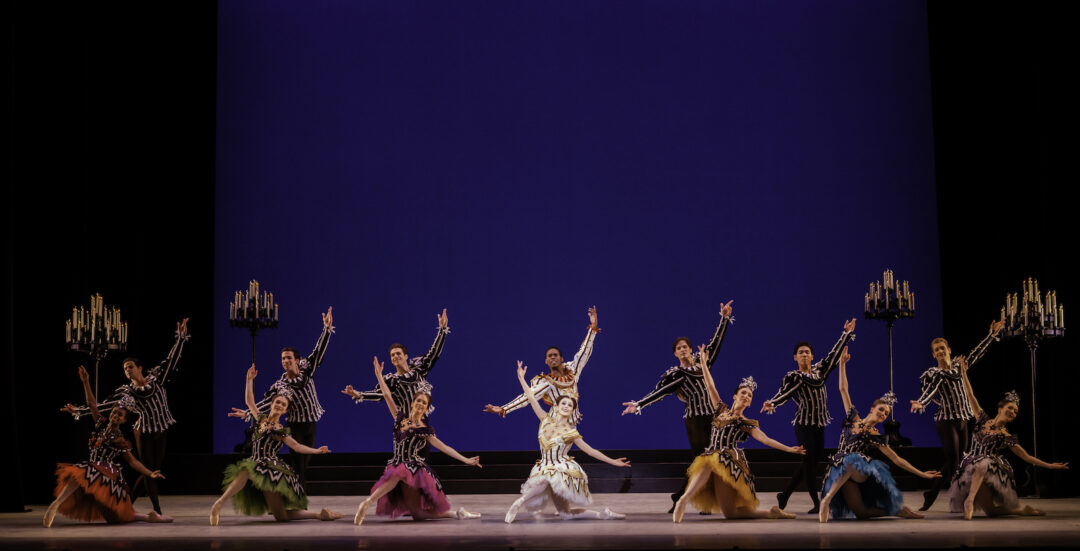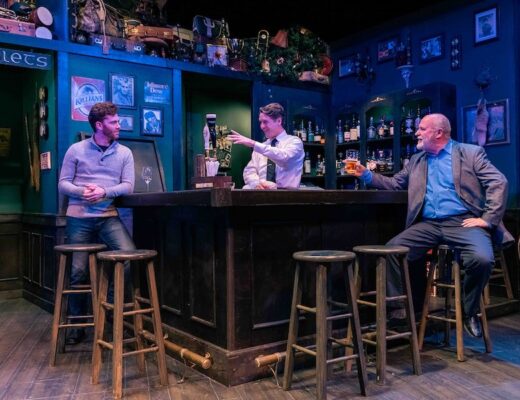By Ilena Peng
This article was first published February 25, 2020 in DC Line here.
In Balanchine + Ashton, which wrapped up a five-day run at the Kennedy Center on Sunday, The Washington Ballet took on the hefty task of capturing the essence of the 20th century’s most monumental choreographers — and it succeeded quite spectacularly.
George Balanchine pioneered American ballet as the New York City Ballet’s founder, creating, beginning in the 1930s, a repertoire of over 90 ballets and a distinct “Balanchine technique.” Sir Frederick Ashton served a similar role in England as the Royal Ballet’s founding choreographer and later as the company’s director, choreographing more than 100 ballets.
“The fact that their works are still relevant, engaging and entertaining to audiences today is a reflection of their true genius,” The Washington Ballet (TWB) artistic director Julie Kent wrote in an online blurb about the production, which featured four works from the two choreographers.
TWB’s company is smaller than the likes of the New York City Ballet and the Royal Ballet — so much so that several of the dancers last week performed in multiple ballets. Fittingly, Balanchine and Ashton might recognize the challenge, having built small companies into balletic monoliths.
The TWB production also favored pared-back scenery — three of the works were staged with no decorations save for a few lamps in Ashton’s Birthday Offering. In the company’s first time performing that and two other works — Ashton’s Méditation from Thaïs and Balanchine’s Slaughter on Tenth Avenue — the TWB dancers commanded the Eisenhower Theater stage without visual distractions. The company last performed the fourth piece, Balanchine’s Allegro Brillante, three years ago at the Warner Theatre.
Balanchine and Ashton often favored stripped-down set designs, focusing solely on the dancers and the music. But they both strove to maintain the traditional grandeur of the Romantic-era story ballet, often choosing to fill the stage with faster jumps, bigger kicks and extended arm movements.
In the first of the production’s four ballets, Ashton’s Birthday Offering, the TWB dancers leaned into their steps and used their upper bodies in a more exaggerated way than usually seen in classical works. The ballet, which was created to celebrate the Royal Ballet’s 25th anniversary in 1956, is both whimsical and elegant.
Birthday Offering juxtaposed quick staccato variations and much slower waltzes. Dancer Ashley Murphy-Wilson’s variation fit into the former category, as she flitted across the stage dressed in red. In contrast, purple-clad dancer Brittany Stone’s movements showed classical roots.
Featuring music by Alexander Glazunov and arrangements by Robert Irving, the ballet opened in a grand celebration as the couples circled around the stage in tandem. In one memorable moment, the dancers formed a diagonal — as soon as a couple reached the end, they ran back to the front, creating a carousel of turns.
In the ballet’s main duet or pas de deux, dancers Eun Won Lee and Gian Carlo Perez evoked a calmer, more gracious mood. Won Lee directed her gaze at the rafters as she entered the stage with bourrées — quick steps that create the impression of gliding. She did the same in arabesques throughout the pas de deux, creating the touching impression that she was thanking someone — perhaps an audience member — for this celebration. Then, in her curtsies, Won Lee looked instead into the theater’s upper tiers.
Maki Onuki and Andile Ndlovu danced Ashton’s Méditation from Thaïs, a pas de deux set to music originally composed by Jules Massenet for the opera Thaïs. The opera tells the tale of a monk who falls in love with a priestess of Venus, the goddess of love.
Onuki, entering the stage with a translucent scarf masking her face, had an ethereal presence, and Ndlovu managed throughout the pas de deux to maintain that dynamic during numerous prolonged lifts. In one, Ndlovu carried Onuki in a seated position, her arms up and palms pressed together — and her silhouette visible on the stage’s backdrop. The ballet left many in the Eisenhower Theater holding their breath until its last moments, when Onuki and Ndlovu embraced with a kiss before Onuki glided off stage en pointe.
“It’s a bit of a fantasy pas de deux, a romantic otherworldliness you don’t get a lot of these days,” said Grant Coyle, a Royal Ballet répétiteur who staged the ballet with TWB.
TWB then performed Balanchine’s Allegro Brillante, a work the choreographer once said “contains everything I know about the classical ballet in 13 minutes.” In truth, it does that and more. In an element made challenging by its length and the need for exquisite timing, carefully designed sequences had each dancer begin a step just as another was completing it. The ballet also played with angles, as the five male dancers jumped and landed in lunges facing alternating corners of the stage.
Unlike the two earlier works, Allegro Brillante was accompanied not only by the Washington Ballet Orchestra but also by solo piano. TWB music supervisor Glenn Sales provided the only soundtrack as the ballet’s main couple — Katherine Barkman and Alex Kramer — danced. The orchestra joined the piano as the ballet’s other eight dancers joined Barkman and Kramer on stage.
The four-part performance ended with Balanchine’s Slaughter on Tenth Avenue, an upbeat and sultry Jazz Age work originally created for the 1936 musical On Your Toes. In the musical, the ballet’s premiere becomes the backdrop for an attempted murder when a jealous Russian dancer hires a mobster to kill a rival.
Dancer Corey Landolt kicked off the ballet in a pink bathrobe, peering from behind the curtains and handing money for the assassination to the Gangster, played by Harry Warshaw. Prancing theatrically across the stage, Landolt drew laughs from the get-go. Warshaw took a seat in the audience, waiting for the moment when he had been instructed to kill Hoofer, danced by Gilles Dellelio.
Dellelio, an apprentice in the company, astonished with his charisma in a prolonged, almost frantic tap solo. And dancer Victoria Arrea stunned as the “Striptease Girl,” flirtatious at first in a pink corset and fringe skirt, and then sultry in a black outfit. In one of the ballet’s most famous moments, Arrea performed a series of high kicks while arched into a deep backbend over Dellelio’s arm. In this madcap show, music by Richard Rodgers accentuates the jazz hands and shimmies incorporated into Balanchine’s choreography.
It marked a contrast for a show that began with audiences oohing and aahing as the Washington School of Ballet’s youngest students adorably performed Kent’s Défilé to celebrate the school’s 75th anniversary. With Slaughter on Tenth Avenue, the end came with a strong dose of humor and bravado from the company.
TWB, while smaller in numbers than some ballet companies, captured the genius of these choreographers in a performance that ran the gamut — intimate in Méditation From Thaïs’ love and Slaughter on Tenth Avenue’s humor, yet palatial and larger than life in Birthday Offering and Allegro Brillante.





No Comments